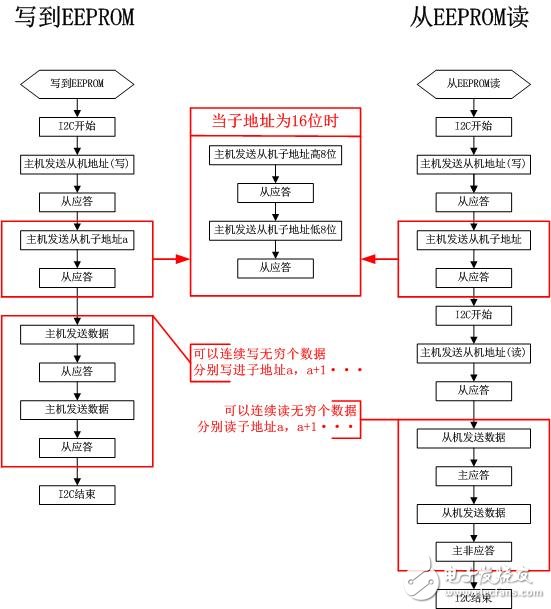I2C bus protocol program
In the process of doing what I was looking for on the Internet is Zhou Ligong's program, I feel pretty good by the way reproduced; in the use of the process must pay attention to timing and time issues.
"i2c.h file"
/ / I2C bus synthesis send function to send multiple bytes of data to the slave
I2C read and write EEPROM flow chart

Bit I2C_Puts(
Unsigned char SlaveAddr,
Unsigned int SubAddr,
Unsigned char SubMod,
Char *dat,
Unsigned int Size
);
//The I2C bus synthesis receive function receives multiple bytes of data from the slave
Bit I2C_Gets
(
Unsigned char SlaveAddr,
Unsigned int SubAddr,
Unsigned char SubMod,
Char *dat,
Unsigned int Size
);
#endif
"i2c.c file"
#include "I2C.h"
//define a delay variable for macro I2C_Delay()
Unsigned char I2C_Delay_t;
#define I2C_Delay(){I2C_Delay_t = (I2C_DELAY_VALUE);while ( --I2C_Delay_t != 0 );}
Void I2C_Start()
{
I2C_SDA = 1; I2C_Delay();
I2C_SCL = 1; I2C_Delay();
I2C_SDA = 0; I2C_Delay();
I2C_SCL = 0; I2C_Delay();
}
Void I2C_Write(char dat)
{
Unsigned char t = 8;
Do
{
I2C_SDA = (bit)(dat & 0x80);
Dat "= 1;
I2C_SCL = 1; I2C_Delay();
I2C_SCL = 0; I2C_Delay();
} while ( --t != 0 );
}
Char I2C_Read()
{
Char dat;
Unsigned char t = 8;
I2C_SDA = 1;//Before reading data, pull SDA high
Do
{
I2C_SCL = 1;
I2C_Delay();
Dat "= 1;
If (I2C_SDA) dat |= 0x01;
I2C_SCL = 0;
I2C_Delay();
} while ( --t != 0 );
Return dat;
}
Bit I2C_GetAck()
{
Bit ack;
//Bus ready, accept response
I2C_SDA = 1; I2C_Delay();
I2C_SCL = 1; I2C_Delay();
Ack = I2C_SDA;
I2C_SCL = 0;
I2C_Delay();
Return ack;
}
/************************************************* *****************************
Function: I2C_PutAck()
Function: Host generates a response bit or non-acknowledgement bit
parameter:
Ack=0: The host generates an answer bit
Ack=1: host generates non-acknowledgement bits
Explanation:
The host should generate an acknowledge bit after receiving each byte of data
After the host receives the data of the last byte, it should generate non-response bit
************************************************** ****************************/
Void I2C_PutAck(bit ack)
{
I2C_SDA = ack;I2C_Delay();
I2C_SCL = 1; I2C_Delay();
I2C_SCL = 0; I2C_Delay();
}
/************
Function: I2C_Stop()
Function: Generate a stop condition on the I2C bus
Explanation:
Stops the I2C bus when SDA rises while SCL is high
Regardless of the level state of SDA and SCL, this function always generates a stop state correctly.
After this function is executed, the I2C bus is idle
***********/
Void I2C_Stop()
{
Unsigned int t = I2C_STOP_WAIT_VALUE;
I2C_SDA = 0; I2C_Delay();
I2C_SCL = 1; I2C_Delay();
I2C_SDA = 1I2C_Delay();
While ( --t != 0 ); //Add a certain delay before the next Start
}
/****
Function: I2C_Puts()
Function: I2C bus synthesis send function to send multiple bytes of data to the slave
parameter:
SlaveAddr: Slave Address (7-bit Pure Address, No Read/Write Bits)
SubAddr: slave address
SubMod: Subaddress mode, 0 - no subaddress, 1 - single byte subaddress, 2 - double byte subaddress
*dat: data to send
Size: The number of bytes of data
return:
0: sent successfully
1: An exception occurred in the sending process
Explanation:
This function adapts well to all common I2C devices, whether or not they have subaddresses
When the slave has no subaddress, the parameter SubAddr is arbitrary, and SubMod should be 0
*****/
Bit I2C_Puts
(unsigned char SlaveAddr, unsigned int SubAddr, unsigned char SubMod,
Char *dat,unsigned int Size)
{
//define a temporary variable
Unsigned char i;
Char a[3];
If ( Size == 0 ) return 0;//check length
a[0] = (SlaveAddr "1"; // Prepare slave address
If ( SubMod 2 ) SubMod = 2;//Check subaddress mode
// determine the subaddress
Switch ( SubMod )
{
Case 0:
Break;
Case 1:
a[1] = (char)(SubAddr);
Break;
Case 2:
a[1] = (char)(SubAddr )" 8);
a[2] = (char)(SubAddr);
Break;
Default:
Break;
}
// Send the slave address (a[0]), then send the subaddress (if there is a subaddress) (a[1], a[2])
I2C_Start();
For ( i=0; i“=SubMod; i++ )
{
I2C_Write(a[i]);
If ( I2C_GetAck() )
{
I2C_Stop();
Return 1;
}
}
//send data
Do
{
I2C_Write(*dat++);
If ( I2C_GetAck() ) break;
} while ( --Size != 0 );
//Send is complete, stop the I2C bus, and return the result
I2C_Stop();
If ( Size == 0 )
{
Return 0;//successfully sent
}
Else
{
Return 1;//An exception occurred during sending
}
}
/******
Function: I2C_Gets()
Function: I2C bus integrated receiver function to receive multiple bytes of data from a slave
parameter:
SlaveAddr: Slave Address (7-bit Pure Address, No Read/Write Bits)
SubAddr: slave address
SubMod: Subaddress mode, 0 - no subaddress, 1 - single byte subaddress, 2 - double byte subaddress
*dat: Save the received data
Size: The number of bytes of data
return:
0: Received successfully
1: An exception occurred during reception
Explanation:
This function adapts well to all common I2C devices, whether or not they have subaddresses
When the slave has no subaddress, the parameter SubAddr is arbitrary, and SubMod should be 0
*****/
Bit I2C_Gets
(unsigned char SlaveAddr, unsigned int SubAddr, unsigned char SubMod,
Char *dat,unsigned int Size)
{
//define a temporary variable
Unsigned char i;
Char a[3];
If ( Size == 0 ) return 0;//Check length, received successfully
a[0] = (SlaveAddr "1"; // Prepare slave address
If ( SubMod 2 ) SubMod = 2;//Check subaddress mode
//If it is a slave with a subaddress, the slave address and subaddress must be sent first
If ( SubMod != 0 )
{
// determine the subaddress
If ( SubMod == 1 )
{
a[1] = (char)(SubAddr);
}
Else
{
a[1] = (char)(SubAddr )" 8);
a[2] = (char)(SubAddr);
}
//Send slave address write, then send subaddress
I2C_Start();
For ( i=0; i“=SubMod; i++ )
{
I2C_Write(a[i]);
If ( I2C_GetAck() )
{
I2C_Stop();
Return 1;
}
}
}
// The I2C_Start() here is a repeat start state for slaves with subaddress
//Slave with no subaddress is normal start state
I2C_Start();
//Send slave address read
I2C_Write(a[0]+1);
If ( I2C_GetAck() )
{
I2C_Stop();
Return 1;
}
//Receive data
For (;;)
{
*dat++ = I2C_Read();
If ( --Size == 0 )
{
I2C_PutAck(1);
Break;
}
I2C_PutAck(0);
}
//The reception is completed, stop the I2C bus, and return the result
I2C_Stop();
Return 0;
}
ZGAR GenkiIppai Pods 5.0
ZGAR electronic cigarette uses high-tech R&D, food grade disposable pod device and high-quality raw material. All package designs are Original IP. Our designer team is from Hong Kong. We have very high requirements for product quality, flavors taste and packaging design. The E-liquid is imported, materials are food grade, and assembly plant is medical-grade dust-free workshops.
From production to packaging, the whole system of tracking, efficient and orderly process, achieving daily efficient output. WEIKA pays attention to the details of each process control. The first class dust-free production workshop has passed the GMP food and drug production standard certification, ensuring quality and safety. We choose the products with a traceability system, which can not only effectively track and trace all kinds of data, but also ensure good product quality.
We offer best price, high quality Pods, Pods Touch Screen, Empty Pod System, Pod Vape, Disposable Pod device, E-cigar, Vape Pods to all over the world.
Much Better Vaping Experience!


ZGAR GenkiIppai 5.0 Pods,ZGAR GenkiIppai Pods 5.0,ZGAR GenkiIppai Pods 5.0 Pod System Vape,ZGAR GenkiIppai Pods 5.0 Disposable Pod Vape Systems, Japanese culture style
ZGAR INTERNATIONAL(HK)CO., LIMITED , https://www.zgarette.com